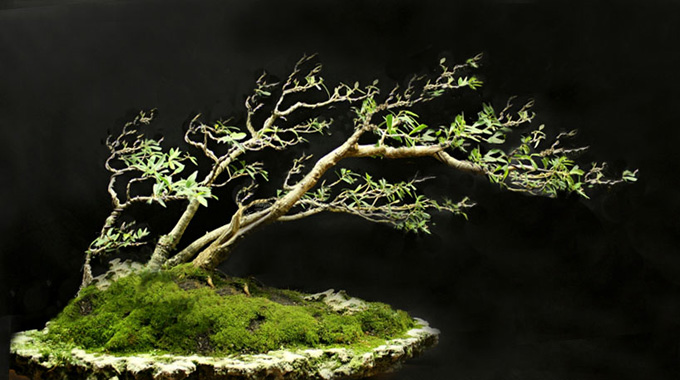 Robert Steven’s simulation of a planting submitted by someone named Bob. In Robert’s words: “Above is my simulation that suggests a strong wind blown effect. I improved the ramification structure, reduced the foliage to enhance the movement of the lines, and eliminated the grasses to avoid irrelevant conditions.” Bob’s original is below.
Robert Steven’s simulation of a planting submitted by someone named Bob. In Robert’s words: “Above is my simulation that suggests a strong wind blown effect. I improved the ramification structure, reduced the foliage to enhance the movement of the lines, and eliminated the grasses to avoid irrelevant conditions.” Bob’s original is below.
Bonsai mastery
I have long been impressed by Robert Steven’s mastery of the art of bonsai and his skill and ease with windswept bonsai (surely one of the most subtle and demanding types of bonsai), illustrates that mastery.
Robert’s Critique
Many people misunderstand that windswept style bonsai is simply formed by leaning the trunk and placing all the branches on one side. It is not that simple, windswept can be created in any style because in nature, wind can blow on any tree, including a tree leaning into the wind.
Windswept is a very advanced bonsai style. To make a good windswept bonsai, in addition to basic design techniques, you need to understand windswept bonsai concepts. More advanced skill is required, especially when it comes developing ramification (branching).
Windswept bonsai is not simply styled by placing all the branches on one side of a slanting trunk. There are conceptual requirements for forming ramification that give a logical sense of how the wind blows: either the wind is blowing gently, or there’s a strong wind, or the style is formed by continuous wind blowing, but not blowing at the moment.
This bonsai, although it suggests a windswept style, does not portray a group of mature trees because of improper ramification. Nor does it suggest an existing wind blowing at this moment. The foliage and the grasses do not give a moving illusion, they all look still.
To create a good windswept bonsai, the key is properly forming the ramification. The best structure is formed by the “clip-and-grow” technique, showing the flowing lines of the tiny twigs with very spare leaves. All the tips are flowing slightly upward in one direction as shown in the pictures below.
On the reverse side, we need to form some side branches with dramatic bending in the direction the wind blows, as shown on the above picture. The idea is to show that the wind causes the twigs to bend, but is not strong enough to bend the branches. The more we can play with this feature, the better the impact is.
Below is one of my windswept bonsai. Windswept bonsai can be created in any style, even on formal upright or a tree that leans into the wind, as long as the ramification is correctly formed to suggest the blowing wind (you can read the complete concept of windswept bonsai in my book Vision of My Soul).
General comments
There is more than one way to design any bonsai and my critiques and recommended solutions might not always fit your taste and personal preferences, but I always try to give my opinion based on artistic and horticultural principles.
To understand my concepts better, please read my books Vision of My Soul and Mission of Transformation which are available at Stone Lantern.
You can also visit my bonsai blog.
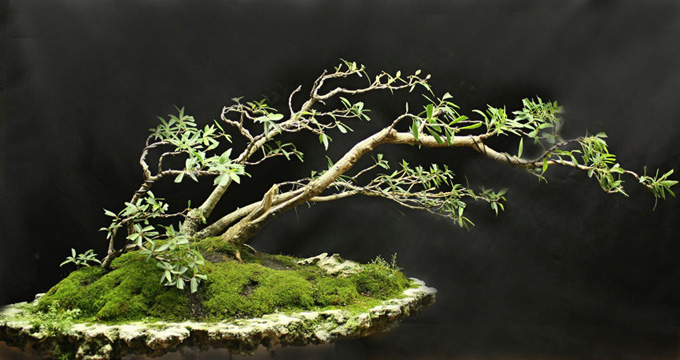
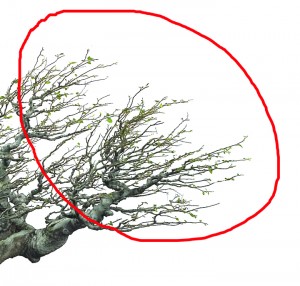
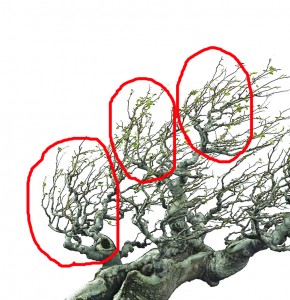
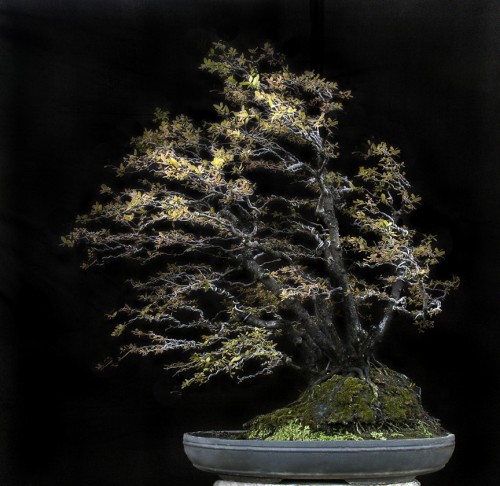
Wayne,
Simple design, yet elegant. It is important to state that this type of windwept effect was indeed developed by Chinese Shuihan Penjing Grand Master, Mr. He Gansun.
Wonderful tree, Robert. Beatifully done.
I am especially interested in the photography and lighting effects in the photo, which are very nicely done. After teaching myself the application of HDR (High Dynamic Range) photography to bonsai (set against a black velvet backdrop), I introduced it, I think, to the bonsai world in my book a few few months ago. The dramatic lighting effects in your photo here seem similar – but not identicle – to those I achieved, and I am wondering if you used HDR tecniques and software or some other means to achieve those effects.
In any event, the lighting and black background suit this tree well, evoking the sensation of a dark storm kicking up to produce the wind gusts, and it adds greatly to the already gorgeous image. Very nice.
Yes Will, I used velvet backdrop…
It is not very true that windswept penjing was developed by He Gan Sun, but indeed he made this style popular after one of his master piece tittled “Hai feng chui fu wu qian nian” (The sea wind blows for 5000 years) to celeberate the return of Hongkong to China, among few other creations with tittles suggesting certain implicit messages, mainly related to the spirit of the nation.
In 1997, he wrote a paper about the so-called “Dong shi penjing” (Moving style penjing) with windswept as one of the “styles” to suggest the movement, which later become his icon. He believes that only with movement (not only windswept, but all other dynamic styles), we can really express the dynamic life of nature, and he suggest the various combination of tree with stone in grouping or forest style to emphasize the natural phenomena..and later become famous as the typical penjing from Hubei.
Just to correct…He Gan Sun is not a “Shuihan” (Water & Land) Penjing Grand Master, but he is one of the most senior generation of penjing art in Hubei province for his “Shushi penjing” (Tree & Rock penjing). He gained his Penjing Master predicate in 1994 by the government as well as by the national organization.
Jose,
As always, thank you for filling us in. However, in this case I think Robert might have something to say. As for me, I don’t know enough about the subject to agree or disagree.
Thanks for filling in a little history for us Robert. As for any details, my knowledge of the subject is close to nonexistent, so I’ll leave that to you and Jose to discuss.
Robert,
Thanks for the additional info. However, I was not suggesting that Mr. He was the originator of windswept penjing, only that this type of branch arrangement for the windswept style is indeed his idea. In 1988, the World Bonsai Friendship Federation published a book entitled “Bonsai of the World”. Preceding the date Hong Kong was handed back to China, being that date in which Master He created the celebrated work you mention, several of Mr. He’s works are featured, including Tree Penjing, water and land penjing, tree and rock pending and rock penjing. On those featuring trees as one of the main components of the composition, every single tree has this arrangement. What makes Mr he’s windswept effect so different is the fact that the trees appear to be withstanding actual momentary wind effects. Previously, windswept penjing, displayed trees with long term wind exposure. Totally different. This info was corroborated by Mr. Zhao Quin quan on several conversations I held with him about this subject.
Warm regards,
Jose Luis
Well done Robert !!!